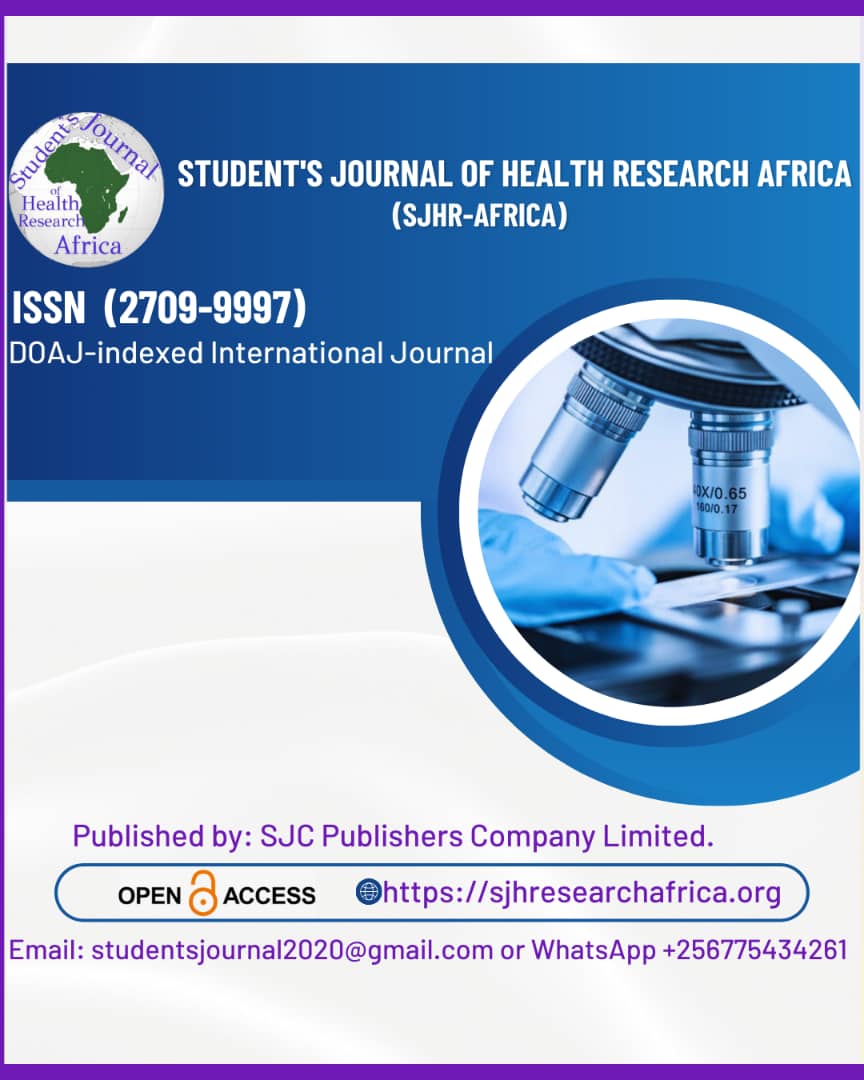Predictors of heart failure at 3-month follow-up in patients undergoing pharmacoinvasive percutaneous coronary intervention for anterior wall STEMI: A cross-sectional study.
DOI:
https://doi.org/10.51168/sjhrafrica.v6i9.2055Keywords:
STEMI, pharmacoinvasive PCI, heart failure, Killip class, left ventricular dysfunctionAbstract
Background
Anterior wall ST-elevation myocardial infarction (STEMI) often leads to left ventricular (LV) dysfunction and clinical heart failure despite timely reperfusion. The pharmacoinvasive percutaneous coronary intervention (PCI) strategy, involving thrombolysis followed by planned PCI, is frequently used in regions where immediate primary PCI is not feasible. Identifying early predictors of heart failure after such interventions can improve risk stratification and follow-up strategies.
Objectives
To identify the baseline angiographic and clinical indicators of heart failure at the 3-month mark in patients who received PCI and thrombolysis for anterior wall STEMI.
Methods
480 individuals who received PCI and thrombolysis for anterior wall STEMI within 24 hours were included in this research. Age, gender, Killip class, cardiovascular risk factors, time to PCI (3–10, 10–17, and 17–24 hours), Baseline data included left ventricular ejection fraction (LVEF) at discharge and TIMI flow prior to and following PCI. At three months, heart failure was defined as echocardiographic LV dysfunction (LVEF <40%) and the presence of NYHA class II–IV symptoms. Independent predictors were found using multivariate logistic regression.
Results
Mean age was 57.3 ± 11.2 years; 82% were male. Sixty-eight patients (14.2%) developed HF at 3 months. HF was more common among those with Killip class ≥II (29.5% vs. 9.8%, p<0.001), delayed PCI (>17 hours) (20% vs. 10.3%, p=0.01), and lower baseline LVEF (40.1% vs. 46.7%, p<0.001). Independent predictors were baseline LVEF <40% (aOR 2.78, 95% CI 1.63–4.72), Killip class ≥II (aOR 2.15, 95% CI 1.24–3.71), and PCI >17 hours (aOR 1.96, 95% CI 1.08–3.57).
Conclusion
Low baseline LVEF, elevated Killip class, and PCI delay independently predict HF at 3 months following pharmacoinvasive PCI for anterior STEMI.
Recommendation
Early risk identification, minimizing PCI delays, and aggressive heart failure prevention strategies
References
McDonagh TA, Metra M, Adamo M, Gardner RS, Baumbach A, Böhm M, et al. 2021 ESC Guidelines for the diagnosis and treatment of acute and chronic heart failure. Eur Heart J. 2021;42(36):3599-726. https://doi.org/10.1093/eurheartj/ehab368
Hellermann JP, Jacobsen SJ, Gersh BJ, Rodeheffer RJ, Reeder GS, Roger VL. Heart failure after myocardial infarction: clinical presentation and survival. Eur Heart J. 2005;26(2):119-27. https://doi.org/10.1016/j.ejheart.2004.04.011
Pfeffer MA, Braunwald E. Ventricular remodeling after myocardial infarction. Experimental observations and clinical implications. Circulation. 1990;81(4):1161-72. https://doi.org/10.1161/01.CIR.81.4.1161
Cohn JN, Ferrari R, Sharpe N. Cardiac remodeling-concepts and clinical implications: a consensus paper. J Am Coll Cardiol. 2000;35(3):569-82. https://doi.org/10.1016/S0735-1097(99)00630-0
Sutton MG, Sharpe N. Left ventricular remodeling after myocardial infarction: pathophysiology and therapy. Circulation. 2000;101(25):2981-8. https://doi.org/10.1161/01.CIR.101.25.2981
Bolognese L, Neskovic AN, Parodi G, Cerisano G, Buonamici P, Santoro GM, et al. Left ventricular remodeling after primary coronary angioplasty: patterns of left ventricular dilation and long-term prognostic implications. Circulation. 2002;106(18):2351-7. https://doi.org/10.1161/01.CIR.0000036014.90197.FA
Gaudron P, Eilles C, Kugler I, Ertl G. Progressive left ventricular dysfunction and remodeling after myocardial infarction: potential mechanisms and early predictors. Circulation. 1993;87(3):755-63. https://doi.org/10.1161/01.CIR.87.3.755
Velagaleti RS, Pencina MJ, Murabito JM, Wang TJ, Parikh NI, D'Agostino RB, et al. Long-term trends in the incidence of heart failure after myocardial infarction. Circulation. 2008;118(20):2057-62. https://doi.org/10.1161/CIRCULATIONAHA.108.784215
Keeley EC, Boura JA, Grines CL. Primary angioplasty versus intravenous thrombolytic therapy for acute myocardial infarction: a quantitative review of 23 randomized trials. Lancet. 2003;361(9351):13-20. https://doi.org/10.1016/S0140-6736(03)12113-7
Ibanez B, James S, Agewall S, Antunes MJ, Bucciarelli-Ducci C, Bueno H, et al. 2017 ESC Guidelines for the management of acute myocardial infarction in patients presenting with ST-segment elevation. Eur Heart J. 2018;39(2):119-77. https://doi.org/10.1093/eurheartj/ehx393
Armstrong PW, Gershlick AH, Goldstein P, Wilcox R, Danays T, Lambert Y, et al. STREAM Investigative Team. Fibrinolysis or primary PCI in ST-segment elevation myocardial infarction. N Engl J Med. 2013;368(15):1379-87. https://doi.org/10.1056/NEJMoa1301092
Cantor WJ, Fitchett D, Borgundvaag B, Ducas J, Heffernan M, Cohen EA, et al. Routine early angioplasty after fibrinolysis for acute myocardial infarction. N Engl J Med. 2009;360(26):2705-18. https://doi.org/10.1056/NEJMoa0808276
Puymirat E, Aissaoui N, Cayla G, Cottin Y, Elbaz M, Henry P, et al. Changes in hospital mortality in patients with acute myocardial infarction in France, 1995-2010: the FAST-MI programme. Heart. 2014;100(14):1107-13.
Ezekowitz JA, Kaul P, Bakal JA, Armstrong PW, Welsh RC, McAlister FA. Declining in-hospital mortality and increasing heart failure incidence in elderly patients with first myocardial infarction. J Am Coll Cardiol. 2009;53(1):13-20. https://doi.org/10.1016/j.jacc.2008.08.067
Jernberg T, Johanson P, Held C, Svennblad B, Lindbäck J, Wallentin L. Association between adoption of evidence-based treatment and survival for patients with ST-elevation myocardial infarction. JAMA. 2011;305(16):1677-84. https://doi.org/10.1001/jama.2011.522
Møller JE, Hillis GS, Oh JK, Reeder GS, Wright RS, Park SW, et al. Wall motion score index and ejection fraction for risk stratification after acute myocardial infarction. Am Heart J. 2006;151(2):419-25. https://doi.org/10.1016/j.ahj.2005.03.042
El Hefny E, Abdelwahab H, Abdo N, El Sharkawy M, El Khashab K. Optimal timing of PCI after thrombolysis in anterior STEMI: impact on LV function and clinical outcome. Egypt Heart J. 2019;71(1):6.
Yancy CW, Jessup M, Bozkurt B, Butler J, Casey DE Jr, Drazner MH, et al. 2013 ACCF/AHA guideline for the management of heart failure. J Am Coll Cardiol. 2013;62(16):e147-239. https://doi.org/10.1016/j.jacc.2013.05.019
Shah AM, Pfeffer MA. The many faces of heart failure after myocardial infarction. Eur Heart J. 2012;33(16):1901-3.
Gruppo Italiano per lo Studio della Sopravvivenza nell'Infarto Miocardico. GISSI-3: effects of lisinopril and transdermal glyceryl trinitrate. Lancet. 1994;343(8906):1115-22. https://doi.org/10.1016/S0140-6736(94)90232-1
Køber L, Torp-Pedersen C, Carlsen JE, Bagger H, Eliasen P, Lyngborg K, et al. A clinical trial of trandolapril in left ventricular dysfunction after MI. N Engl J Med. 1995;333(25):1670-6. https://doi.org/10.1056/NEJM199512213332503
Killip T, Kimball JT. Treatment of myocardial infarction in a coronary care unit. Am J Cardiol. 1967;20(4):457-64. https://doi.org/10.1016/0002-9149(67)90023-9
Steg PG, Goldberg RJ, Gore JM, Fox KA, Eagle KA, Flather MD, et al. Baseline characteristics, management practices, and in-hospital outcomes of patients hospitalized with acute coronary syndromes in the Global Registry of Acute Coronary Events (GRACE). Am J Cardiol. 2002;90(4):358-63. https://doi.org/10.1016/S0002-9149(02)02489-X
Kober L, Torp-Pedersen C. Clinical outcomes after MI: the importance of LV function. Am J Cardiol. 2003;92(9A):3J-7J.
Wu KC, Zerhouni EA, Judd RM, Lugo-Olivieri CH, Barouch LA, Schulman SP, et al. Prognostic significance of microvascular obstruction by MRI. Circulation. 1998;97(8):765-72. https://doi.org/10.1161/01.CIR.97.8.765
Downloads
Published
How to Cite
Issue
Section
License
Copyright (c) 2025 Dr. Ramesh R. S, Dr. Praveen Velappan, Dr . Bijesh S

This work is licensed under a Creative Commons Attribution-NonCommercial-NoDerivatives 4.0 International License.





















